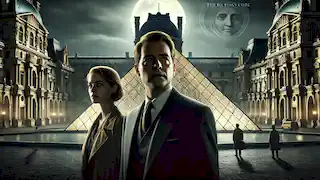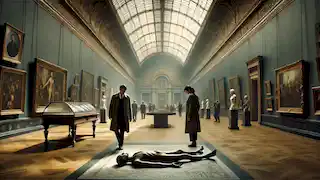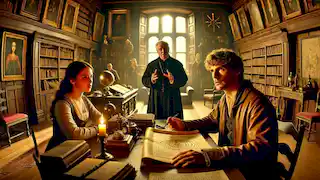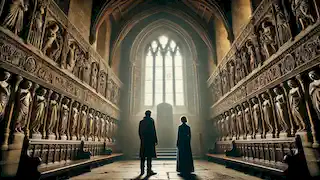The Da Vinci Code
Reading time: 8 min

About this story: The Da Vinci Code is a Historical Fiction from France set in the Renaissance This Dramatic tale explores themes of Redemption and is suitable for Adults. It offers Cultural insights. A race against time to uncover the ancient secrets of the Holy Grail.
Introduction:
*The Da Vinci Code*, written by Dan Brown, is a bestselling mystery thriller that follows Harvard symbologist Robert Langdon and cryptologist Sophie Neveu as they uncover a conspiracy involving a religious mystery hidden for centuries. The novel, set in Europe, combines elements of art history, cryptology, secret societies, and religious symbols. A fast-paced narrative, it revolves around the search for the Holy Grail, rooted in a mystery that challenges the foundations of Christianity. Published in 2003, *The Da Vinci Code* is the second book featuring Robert Langdon, and its provocative themes have sparked worldwide discussions about faith, religion, and historical truth.
The Mystery Begins
The story opens at the Louvre Museum in Paris, where Jacques Saunière, the museum's curator, is fatally wounded by a mysterious albino monk named Silas. Before dying, Saunière leaves behind a cryptic message, his body positioned in a strange manner resembling Leonardo da Vinci’s *Vitruvian Man*. This setup of the murder immediately draws attention to an unusual connection between art, secret codes, and an ancient religious conspiracy.
Robert Langdon, a Harvard symbologist, is summoned to the scene by the French police, who believe he may be able to decipher the code Saunière left behind. Langdon, however, is unaware that the police suspect him of the murder. Sophie Neveu, a cryptologist with the French Judicial Police and Saunière’s estranged granddaughter, enters the story. She secretly warns Langdon that he is being framed and together they escape from the Louvre to unravel the puzzle left by Saunière.

The Journey of the Grail
As Langdon and Sophie investigate Saunière’s murder, they discover clues that point toward the existence of a secret society known as the Priory of Sion. Saunière was a key member of this organization, which has been protecting the secret of the Holy Grail for centuries. The Grail, they learn, is not a cup but a person, and it is believed to be the bloodline of Jesus Christ, suggesting that Christ was married to Mary Magdalene and had descendants. This revelation challenges traditional Christian doctrines, posing a significant religious controversy.
The two protagonists find themselves pursued by both the French police and members of the Catholic organization Opus Dei, particularly Silas, who was manipulated into committing the murder. The head of Opus Dei, Bishop Aringarosa, and a shadowy figure known only as “The Teacher,” orchestrate a complex scheme to retrieve the Grail and keep its secret safe.
As Langdon and Sophie follow the trail of clues, they encounter a series of riddles, anagrams, and hidden symbols embedded in famous works of art, including those of Leonardo da Vinci. One of the key locations in the novel is the Church of Saint-Sulpice in Paris, where they discover that the secret of the Grail is protected by a series of codes and ciphers that only those initiated into the Priory of Sion can solve.
The Code Breaker and the Historian
In their quest, Langdon and Sophie seek the help of Sir Leigh Teabing, a British Grail historian who lives in Château Villette. Teabing reveals that the Grail is not just a physical object but a complex metaphor for a long-suppressed truth about the role of women in Christianity. The suppression of this truth, according to Teabing, was perpetuated by the early church to maintain its authority. He explains that the Priory of Sion has been safeguarding documents (the Sangreal documents) that prove the existence of the Grail bloodline. These documents are believed to be hidden with the Grail itself.
Teabing, Langdon, and Sophie soon realize that the only way to solve the puzzle is to follow the clues Saunière left behind, including his references to da Vinci’s artwork and secret codes. They decode anagrams, identify ciphers, and examine religious symbols, traveling through Paris and London in search of the hidden Grail. Along the way, they uncover centuries-old documents, exposing the secrets of the Church and the power struggles that have shaped history.

Betrayal and Revelation
As the trio continues their pursuit, it becomes clear that not everyone can be trusted. Teabing, who seemed to be an ally, is eventually revealed to be "The Teacher," the mastermind behind the entire scheme. His goal is to reveal the truth of the Grail to the world, even if it means causing global chaos and undermining the foundations of Christianity. Teabing’s betrayal puts Langdon and Sophie in grave danger, as they are now caught between the police, Opus Dei, and Teabing's manipulative plans.
Throughout the novel, Dan Brown uses complex puzzles and historical references to weave a narrative that questions established religious beliefs and presents alternative interpretations of historical events. The characters wrestle with their personal beliefs, particularly Sophie, who learns more about her family’s role in protecting the Grail secret. In the final chapters, Langdon and Sophie confront Teabing in a dramatic showdown that ties together the various plot threads of the novel.
The Final Puzzle and Conclusion
The climax of *The Da Vinci Code* takes place at Rosslyn Chapel in Scotland, a location deeply connected to the legend of the Grail. Langdon and Sophie discover that the Grail is not buried beneath the chapel, as they were led to believe, but rather that the secret of the Grail is symbolic, representing the continuation of the Grail bloodline. Sophie is revealed to be the last living descendant of Jesus Christ and Mary Magdalene, a discovery that shakes her to her core but also brings her a sense of peace and understanding.
The novel concludes with Langdon reflecting on the Grail’s significance. He realizes that the Grail’s true power lies not in physical evidence or historical documents, but in the personal faith and belief it inspires. The final scene finds Langdon back in Paris, contemplating the ancient mysteries that have shaped human history, as well as the complex relationship between religion, power, and truth.
Throughout *The Da Vinci Code*, Dan Brown blends fact and fiction, drawing on real historical events and figures, such as Leonardo da Vinci, and mixing them with speculative theories. This combination has made the novel controversial but also incredibly engaging for readers around the world. The novel raises questions about history, truth, and belief, encouraging readers to explore the complex relationship between religion and society.

Themes and Symbolism
Several recurring themes emerge in *The Da Vinci Code*, including the tension between faith and science, the role of women in religion, and the power of secret knowledge. One of the central messages of the novel is the idea that history is written by the victors and that certain truths are hidden to maintain power. The Priory of Sion and the Vatican represent opposing forces in this struggle, with one group seeking to protect the Grail secret and the other attempting to suppress it to preserve the status quo.
Another important theme is the power of symbols and codes. The novel is filled with references to symbols, both religious and artistic, that serve as clues in the search for the Grail. Brown uses these symbols to explore the ways in which humans have used art, language, and ritual to convey hidden meanings throughout history. This theme is particularly evident in the novel’s use of famous works of art, such as da Vinci’s *The Last Supper*, which is said to contain clues about the true nature of the Grail.
Finally, the novel addresses the theme of personal faith. While the characters are embroiled in a quest for historical truth, they each have their own personal journeys of faith. For Sophie, this journey involves reconciling her family’s past with her own beliefs, while Langdon must come to terms with the implications of the Grail’s existence on his own understanding of religion. In the end, *The Da Vinci Code* suggests that faith is a deeply personal matter, one that transcends historical fact and religious dogma.

Legacy and Impact
Since its publication, *The Da Vinci Code* has had a significant cultural impact. It has been translated into numerous languages, adapted into a film, and sparked debates about religion, art, and history. Critics have praised the novel’s fast-paced narrative and intricate puzzles, while others have criticized its historical inaccuracies and controversial portrayal of religious themes. Despite this, *The Da Vinci Code* remains a major work of popular fiction, one that has inspired millions of readers to explore the mysteries of the past.
The novel’s success is largely due to its ability to combine elements of thriller fiction with deep philosophical questions. It encourages readers to think critically about the nature of truth and the role of institutions in shaping history. While *The Da Vinci Code* is a work of fiction, its themes resonate with real-world issues, making it a powerful and thought-provoking story.










